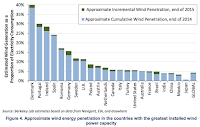That is the TL;DR version of the annual Wind Technologies Market Report just released by the US Department of Energy and Lawrence Berkeley National Laboratory (LBNL).
With 73,992 MW, the US is now the No. 2 country in the world in installed wind capacity (after China, which has a mind-boggling 145,053 MW). And we are No. 1 in actual wind electricity generated.
All that wind only provides about 5.6 percent of US electricity, though, which puts us well behind leaders like Denmark (40 percent), Portugal, Ireland, and Spain (between 20 and 30 percent).
So we’ve got a long way to go to catch up with Denmark (and its amazing energy policies), but we’re making progress.
There’s lots, and I mean lots, more in the report. Here are the three most impressive ways wind is kicking ass.
- Wind power is getting cheaper
- Wind turbines are getting better
- Wind installations are blowing up
And the heated pace of installations is expected to continue, especially as developers take advantage of the dwindling PTC. (The PTC is a tax credit given to wind developers based on electricity production from their projects; it is now set to phase out over five years.)
...
Turns out, state-of-the-art turbines could increase the US land suitable for wind development by 67 percent.
Here’s a cool map. The dark blue is land where today’s most familiar, established turbines can achieve a minimum of 30 percent CF. Lighter blue areas are where the best of today’s turbines can do that. Orange is where state-of-the-art turbines can do it.
So wind is coming, even to the Southeast.
The optimistic scenario for US wind is as follows. Over the next five years, the PTC will phase out. That will drive a continuing surge in installations, as developers race to take advantage of it. That buildout will bring continuing improvements in cost and performance. Those improvements will outrun the decline in the PTC and wind will stand on its own two feet by 2020, even without a carbon price.
...
Bonus additional ass kicking
After I published this, I remembered a few things I wanted to add.
- Wind power is extraordinarily popular with the American people. This Morning Consult post rounds up some of the polling. Around 90 percent of Americans believe the government should encourage wind energy — and that includes 80 percent of Republicans (some of the top wind states are run by Republicans). Always worth remembering: Climate change is a controversial issue, divided along partisan lines, but clean energy is not. Everyone loves clean energy.
- Wind power also employs a lot of Americans — 88,000, at last count. In fact, BLS says that wind turbine technician is the fastest growing profession in the country. The Dept. of Energy says wind power could support up to 380,000 jobs by 2030.
- Europe has had a robust offshore wind industry for a while, but the US has lagged in that area — there are zero offshore wind turbines currently operating in the US. That may finally be changing, though. The first US offshore wind farm (a modest affair) is expected to begin operation this fall. And Massachusetts just passed a bill that would require its utilities to get 1,600 MW of their power from offshore wind over coming decades. It's all happening.
Read more at Bigger, Better, Cheaper: Wind Power Is Flourishing in the US

No comments:
Post a Comment